Craft Tables for Sewing, Quilting, and Paper Crafts

The thing about crafting at the dining table is eventually you stop clearing it off. Your fabric stays there. Your Cricut lives there. Someone suggests eating dinner and you look at them like they've proposed dismantling the Sistine Chapel.
Regular desks weren't designed for cutting mats and sergers. The proportions are wrong. The storage doesn't accommodate rolls of vinyl. You can't fit your knees under most of them while running a sewing machine. And nobody put thread spindles on an IKEA desk because IKEA doesn't make desks for people who need thread spindles.
Craft tables exist as their own furniture category because crafters kept trying to make regular furniture do things it wasn't built for, and eventually someone said "what if we just made tables for this specific chaos?"
Quick Comparison
| Table | Work Surface | Height | Storage Features | Weight |
|---|---|---|---|---|
| Sauder Craft Pro Series | 60×30 inches | 35.98 inches | 3 removable drawers, open shelving both sides | 162 lbs |
| South Shore Counter-Height | 53.25×26.75 inches | 34 inches | 14 cube shelves, 4 baskets, drawer, cabinet, ribbon rod | 123 lbs |
| Venture Horizon Project Center | 55×41 inches | 38.5 inches | 18 cube compartments (12×10 inch openings) | Not specified |
| Giantex Craft Table | 53×24 inches | 36 inches | 14 cube shelves, drawer, cabinet, side compartments | 123 lbs |
| Sew Ready Hobby Table | 58.75×36.5 inches | 29.75-38.75 inches (adjustable) | 2 mesh drawers, lower shelf, folds to 12.25 inches | 58 lbs |
| South Shore Crea with Storage | 53.25×23.5 inches | 30 inches | 2 interchangeable modules, 5 angled shelves, drawer | Not specified |
What Actually Defines a Craft Table
Working surface dimensions trend larger than standard desks. Where office furniture tops out around 48 inches wide, craft tables routinely hit 53-60 inches to accommodate cutting mats, fabric yardage, and the physical reality of quilting.
Height runs taller than desk standard. Most craft tables land at 34-36 inches versus the desk norm of 29-30 inches. Standing to cut fabric for three hours changes the ergonomic requirements. The extra height means less hunching, which your spine notices after about 45 minutes.
Storage gets specific. Not "here's a drawer for pens," but "here's a compartment sized for 12×12 paper stock" or "here's a shelf that holds embroidery thread spools." The furniture acknowledges that crafters accumulate weirdly-shaped supplies that need dedicated homes.
Some tables put drawers on both sides. Some include adjustable shelving that angles to display paper. Some feature magnetic closures because crafters tend to work with their hands full and need doors that stay shut without requiring a free finger.
The Sauder Craft Pro Series
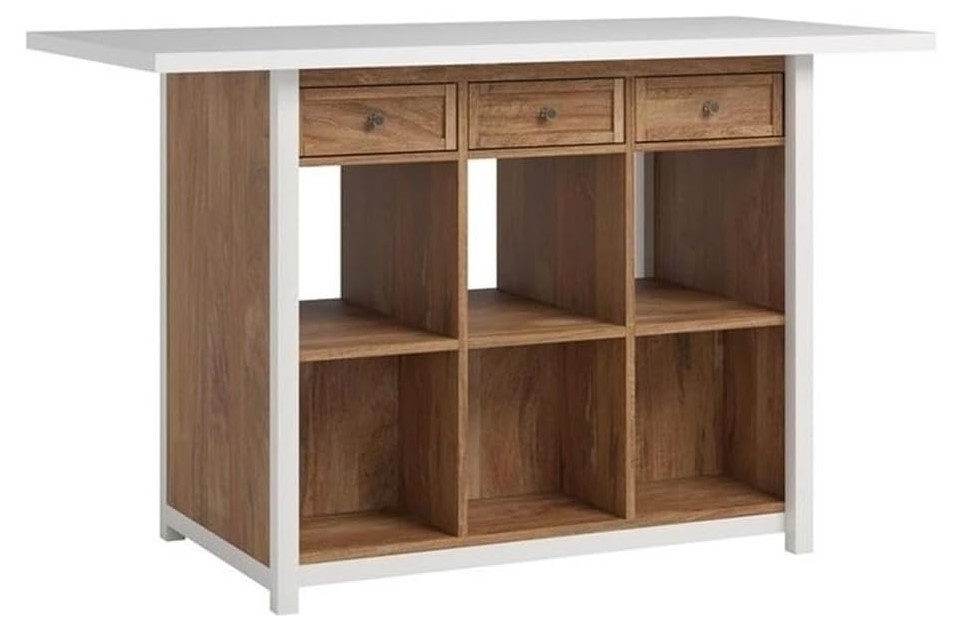
Key specs:
- 60×30 inch work surface
- Three removable center drawers (20 lb capacity each)
- Open shelving both sides (30 lb capacity per shelf)
- Heat/stain/scratch-resistant melamine top
- Available in Sindoori Mango, White, or Mystic Oak
- 162 pounds assembled
The first thing people notice is the three fat drawers running down the center. They slide out from either side, which sounds like a small detail until you're working and realize you can grab scissors from whichever direction you're standing. Accessibility becomes this weird gift you didn't know you needed.
Those drawers also lift out completely. They function as trays you can haul to your work surface, dump supplies onto the table, and not spend 40 seconds digging through a drawer while holding fabric with your other hand. It's the furniture equivalent of someone saying "I watched people actually craft and then designed around what they were doing."
The melamine top tolerates heat and won't scratch when you drag a cutting mat across it. Crafters report setting hot glue guns directly on the surface, which manufacturers don't typically encourage but which happens anyway because crafters work fast and don't always have time for trivial concerns like "protecting surfaces."
Shelving runs along both sides with enough vertical space for plastic bins or to just stack fabric. The open design means you can see what's stored without opening doors, which matters when you're mid-project and need to locate specific supplies without disrupting your momentum.
Finished on all sides, so it works as a room divider or against a wall. The Sindoori Mango finish shows up in craft room photos looking like someone cared about aesthetics, which some people do and some people absolutely don't, but the option exists.
Assembly takes about an hour with two people. The thing weighs 162 pounds, so placement becomes a permanent decision. Where you put it is where it's staying unless you have strong feelings and stronger friends.
South Shore Crea Counter-Height Craft Table
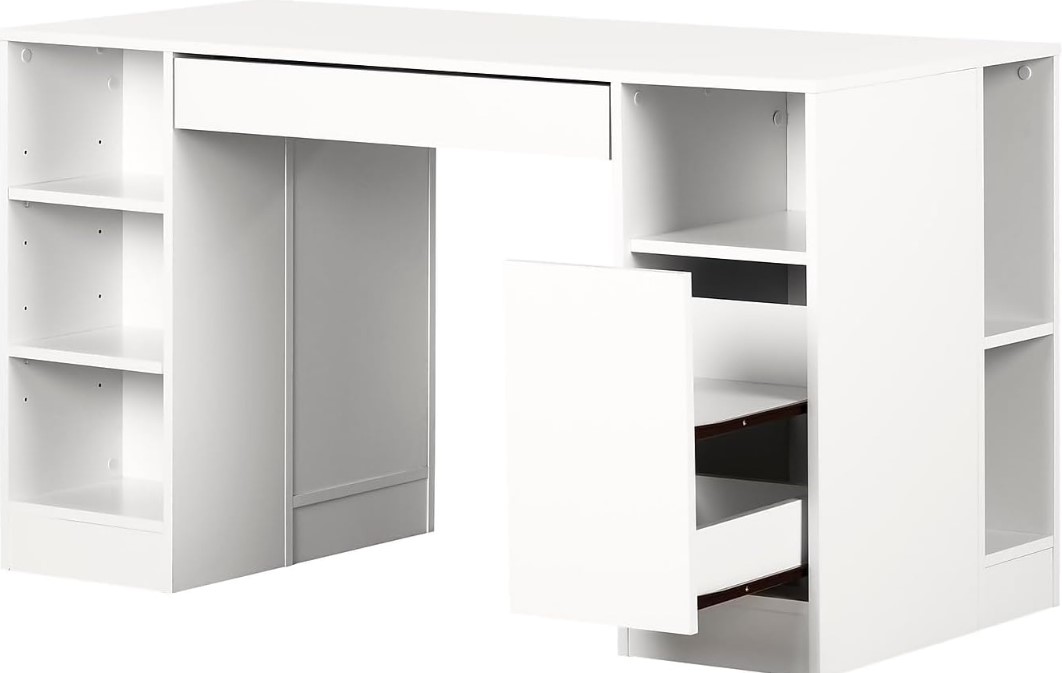
Key specs:
- 53.25×26.75 inch work surface at 34 inches high
- Cabinet with two shelves plus adjustable shelf
- Large drawer with metal slides
- 14 cube storage shelves (eight adjustable, can be slanted)
- Four storage baskets included (two large, two medium)
- Built-in rod for ribbon spools
- Scratchproof and water-resistant top
- 123 pounds assembled
This table runs 34 inches tall, which puts it in that sweet spot where standing work doesn't require hunching and sitting work happens on a stool rather than a chair. Counter-height means something specific to people who spend hours cutting fabric or stamping cards.
Eight adjustable shelves can tilt at angles. This seems like unnecessary complexity until you're storing cardstock or vinyl sheets and realize vertical storage means you can flip through options like files instead of unstacking everything to reach the bottom piece. Someone thought about paper crafters specifically.
A rod runs through one section holding ribbon spools. Not a hook. Not a shelf where spools roll around. An actual rod that acknowledges ribbons come on spools and spools need to hang. The furniture admits what supplies actually look like.
The included baskets measure large and medium, which means something in the bin industry but translates to "holds fabric scraps" and "holds smaller fabric scraps" in practical terms. Four baskets ship with it because crafters accumulate loose materials that need containers, and the table designer apparently watched this happen.
Cabinet space with a magnetic catch holds larger items. The door stays closed without latching, which matters when you're approaching with full hands and can't perform the three-point turn required by traditional cabinet hardware.
The water-resistant top handles spills, which happen more often in craft spaces than people planning craft spaces seem to anticipate. Paint water tips. Dye migrates. Mod Podge escapes containment. The surface acknowledges these realities.
Drawer slides on metal tracks, not plastic, so they don't develop that grinding resistance after six months. The drawer holds 25 pounds, which accommodates scissors, rotary cutters, rulers, and the accumulated weight of craft tools that seem small until you gather them all in one container.
Venture Horizon Project Center Desk
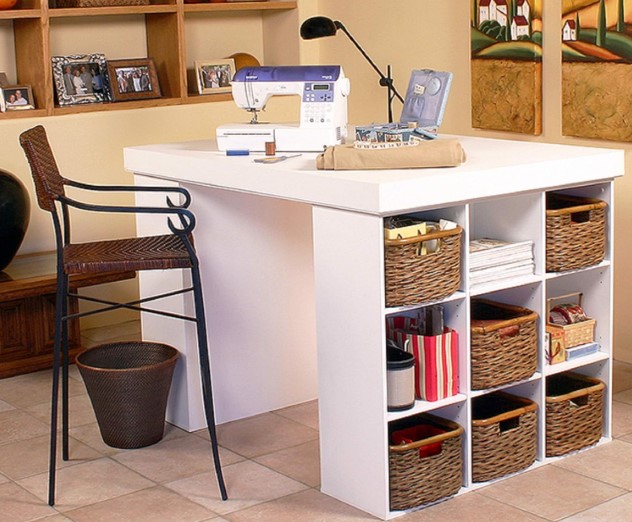
Key specs:
- 55×41 inch work surface at 38.5 inches high
- 18 cube storage compartments (9 per side)
- Each cubby: 12×10 inch opening
- Adjustable shelving
- Available in White, Black, Oak, or Walnut
- Made in USA
Eighteen cubbies arranged in two vertical towers flanking a work surface. Each opening measures 12×10 inches, which happens to match standard storage bin dimensions. This isn't coincidence. The furniture was designed around what containers people actually buy.
The table stands 38.5 inches tall. This is standing-work height. Cutting fabric. Stamping cards. Any task where you're moving around the table rather than sitting still. The proportions assume you'll be on your feet.
Adjustable shelving means the cubbies can be reconfigured based on what you're storing. Tall bins, short bins, or no bins - just stacked fabric. The flexibility acknowledges that crafters accumulate different supplies depending on what they're into, and one storage configuration doesn't work for everyone.
Fifty-five inches wide with 41 inches of depth gives enough room for a cutting mat, a sewing machine, and space to actually work around both. Crafters operating multiple tools simultaneously report the surface accommodates their spread without requiring constant reorganization.
The table works from all sides because it's finished on every surface. You can position it as a room divider, back it against a wall, or put it in the middle of a space. The storage towers provide access from both front and back, which matters in room layouts where you're working around existing furniture.
Made in the USA from engineered wood. Ships in multiple pieces. Assembly requires time and attention to instruction diagrams. The cube structure means lots of individual shelves fitting into vertical supports, which sounds tedious because it is tedious, but results in a stable structure that doesn't wobble under working conditions.
Four finish options let it match existing furniture or stand as a deliberate contrast. Oak reads traditional. White reads contemporary. Black reads industrial. Walnut reads mid-century. The aesthetics range covers whatever craft room vibe someone's cultivating.
Giantex Craft Table with Storage
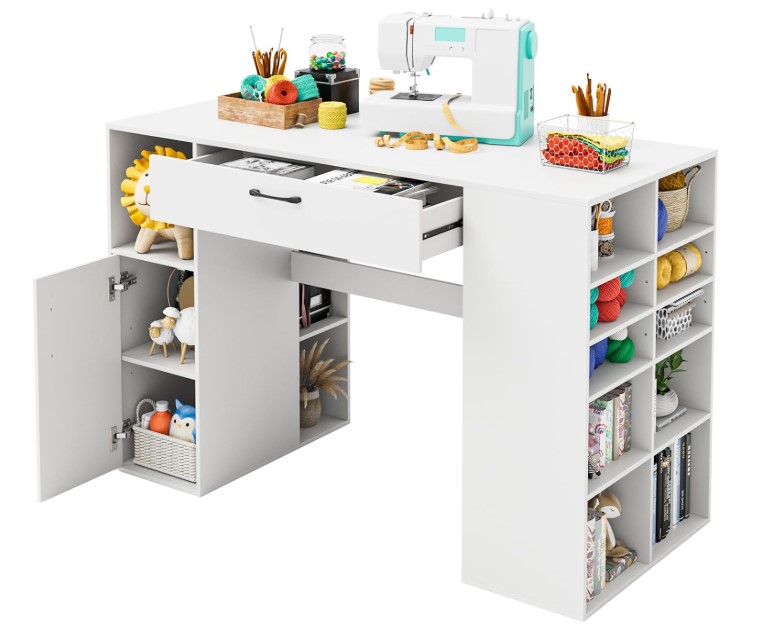
Key specs:
- 53×24 inch work surface at 36 inches high
- 14 cube storage shelves
- Large drawer with metal slides
- Cabinet with two adjustable shelves
- Small side compartments with fixed shelf
- 265 lb weight capacity on tabletop, 25 lb in drawer
- 123 pounds assembled
Fourteen storage cubes arranged in a grid next to the work surface. The cubby system puts supplies at arm's reach while keeping the work area clear. Crafters working on the table don't have to stop, walk to storage, retrieve supplies, walk back. Everything's right there.
The cabinet includes two shelves that adjust to accommodate different storage needs. Tall items, short items, or remove a shelf entirely for one large compartment. The flexibility means the space adapts rather than forcing supplies to conform to fixed dimensions.
Side compartments with a fixed shelf create narrow vertical storage. The dimensions work for binders, magazines, or rolls of wrapping paper - things that are tall and skinny and awkward to store horizontally. Someone looked at what crafters actually keep in their spaces.
Counter height at 36 inches suits standing work. Cutting glass, quilting, stamping - tasks that involve movement around the table rather than stationary sitting. The elevation means less bending, which accumulates significance over multi-hour projects.
The drawer rides on metal slides rated for 25 pounds. This holds scissors, rulers, rotary cutters, and other hand tools without developing the grinding resistance plastic slides develop after moderate use. Metal hardware lasts through repeated opening and closing.
Engineered wood construction with reinforced crossbar adds stability. The frame doesn't wobble when you're working on the surface, which matters when you're cutting fabric or using tools that require a steady work plane.
Magnetic catch on the cabinet door means it stays closed without requiring a hand to shut it properly. Small detail that matters when approaching storage with full hands mid-project.
Sew Ready Hobby and Cutting Table
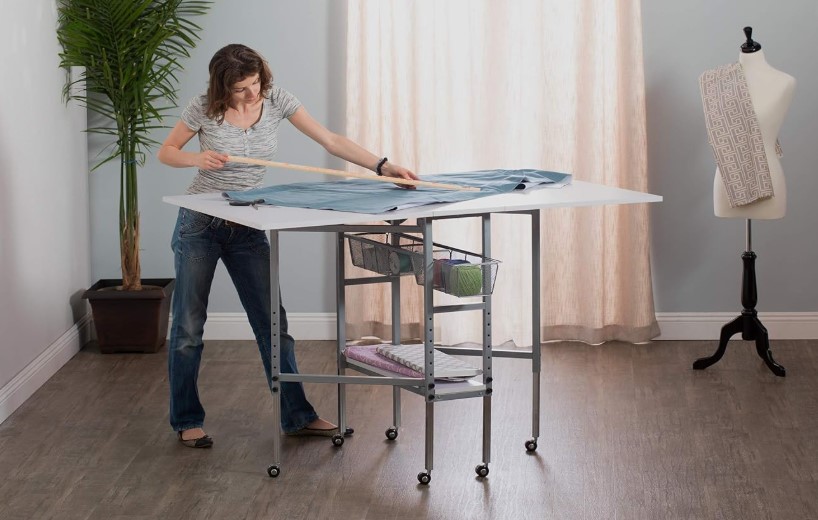
Key specs:
- 58.75×36.5 inch work surface when extended
- Height adjustable from 29.75 to 38.75 inches (1.5 inch increments)
- Two slide-out mesh storage drawers
- Lower shelf for additional storage
- Six floor casters (four locking)
- Folds to 12.25 inches wide for storage
- 58 pounds
The table adjusts from 29.75 to 38.75 inches in 1.5-inch increments. Turn a knob, shift the height. This isn't a feature people think they need until they're three hours into a quilting session and their back starts sending diplomatic protests. Being able to raise the surface transforms standing work from endurance test to sustainable activity.
Two folding side panels extend the work surface to 58.75 inches, then fold back down when not needed. The center section stays at 10.75 inches, so the table maintains some work surface even when collapsed. Extended, it accommodates fabric cutting and quilting. Folded, it fits through doorways.
Mesh drawers slide out from the center section. The wire construction means you can see what's stored without opening anything - thread colors, tool handles, supply containers all visible at a glance. Visual inventory speeds up workflow when you're mid-project and need something specific.
Six casters make the table mobile. Four lock to hold position during work. The combination means you can roll it to optimal lighting, lock it down for stable cutting, then wheel it aside when you need the floor space. Furniture becomes temporary rather than permanent room fixtures.
Folds to 12.25 inches wide. This fits in closets, slides behind doors, or tucks between furniture. The fold-away capability appeals to crafters working in multi-purpose spaces where tables can't stay deployed permanently.
Lower shelf provides additional storage. The open design accommodates larger items that don't fit in drawers - die-cutting machines, fabric bins, or project containers. Access from above means you're not bending to floor level repeatedly.
Powder-coated metal frame handles workshop conditions. Fabric dust, thread bits, occasional moisture from paint water - the finish doesn't chip or rust under typical craft room environmental conditions.
Two versions exist: plain tabletop or gridded surface with measurement lines. The grid version shows inch and centimeter markings plus radial and angle lines. Quilters and dressmakers use the built-in measurements for cutting without adding separate rulers to the surface.
South Shore Crea Craft Table with Open and Closed Storage

Key specs:
- 53.25×23.5 inch work surface at 30 inches height
- Two interchangeable storage modules
- One drawer with metal slides
- Five adjustable 12×12 inch shelves (can be angled)
- Multiple open and closed compartments
- Made in North America
The two storage modules swap positions. You can put the angled shelves on the left or right depending on whether you're left-handed or right-handed, and where the table sits in your room. The interchangeability means the furniture adapts to space constraints rather than forcing room layout to accommodate fixed furniture orientation.
Five shelves adjust to angle for storing 12×12 paper stock. The slanted position lets you flip through paper like files instead of lifting entire stacks to access sheets at the bottom. Scrapbookers and card makers accumulate dozens of paper types, and vertical angled storage means visible inventory without excavation.
Standard desk height at 30 inches makes this one of the shorter craft tables. Works with regular desk chairs, which matters if you already own seating and don't want to buy taller stools. The lower height suits seated work - detailed paper crafts, jewelry making, or any task requiring fine motor control over extended periods.
Drawer under the work surface holds laptops, tablets, and frequently-used tools. Metal slides prevent the grinding resistance that develops with plastic hardware. The drawer pulls out smoothly after repeated use rather than requiring progressively more force.
Closed storage compartments with doors hide supplies that don't need to be visible. Some crafters like seeing everything at a glance. Some prefer visual quiet. The combination of open and closed storage accommodates both approaches within one piece of furniture.
Made in North America from non-toxic laminated particleboard. Ships in two boxes because the assembled size exceeds what fits in single-box shipping dimensions. Packaging separates the table surface from the storage modules for transportation.
Contemporary finish in Pure White works in various room aesthetics. The neutral color doesn't compete with stored supplies or existing furniture. It reads clean and organized even when the actual craft supplies are chaotic.
Laminated on all sides means it works against walls or as a room divider. The back surface looks finished rather than showing raw particleboard edges. Placement flexibility matters in smaller spaces where furniture has to work in multiple configurations.
Frequently Asked Questions
How much assembly time do craft tables require?
Assembly times cluster around 1-2 hours for most craft tables. The Sauder Craft Pro takes about an hour with two people. The South Shore models average 2-3 hours. The Venture Horizon Project Center runs longer - about 3-4 hours - because of the 18 individual cube compartments requiring precise alignment. Folding tables like the Sew Ready assemble faster, around 30-45 minutes, since they have fewer components. Heavy tables need two people for lifting and positioning even if one person handles the actual assembly steps.
What's the difference between craft table height and regular desk height?
Standard desks measure 29-30 inches tall, designed for seated work with feet flat on the floor. Craft tables range from 30-38.5 inches. Counter-height models (34-36 inches) suit standing work like fabric cutting or quilting where you're moving around the surface. The taller height reduces bending and back strain during multi-hour projects. Some tables adjust between heights to accommodate both sitting and standing work positions.
Do craft tables hold sewing machines and die-cutting equipment?
Most craft tables accommodate sewing machines, Cricuts, Silhouettes, and similar equipment. The Sauder Craft Pro and South Shore counter-height models handle sewing machines on their work surfaces while leaving room for cutting mats. The Giantex supports up to 265 pounds on its tabletop, which covers heavy quilting machines. Check machine dimensions against work surface measurements - standard home sewing machines need about 15-17 inches of width, while sergers require more space.
Can craft tables fold for storage in small spaces?
The Sew Ready Hobby and Cutting Table folds to 12.25 inches wide and includes casters for mobility. Most other craft tables in this category remain stationary once assembled due to weight and structure. The Sauder Craft Pro weighs 162 pounds, the South Shore models around 123 pounds, and the Venture Horizon similar. These tables work in dedicated craft rooms or permanent setups rather than spaces requiring frequent furniture reconfiguration.
What makes craft table storage different from regular desk storage?
Craft tables include storage sized for craft-specific supplies. Angled shelves hold 12×12 paper stock. Cube compartments match standard bin dimensions. Some feature ribbon spools, others include adjustable shelving for varying item heights. Drawers accommodate scissors, rotary cutters, and rulers rather than just pens and paper clips. The storage acknowledges that craft supplies come in different shapes and sizes than office supplies.
Do craft tables require special maintenance?
Melamine and laminated surfaces wipe clean with damp cloths. Avoid harsh chemicals that might damage protective coatings. Check drawer slides periodically - metal slides need occasional lubrication if they start sticking. Tighten hardware that loosens over time from repeated drawer use. Keep weight within stated limits - overloading shelves can cause sagging. Protect surfaces from hot tools like glue guns even though many tops are heat-resistant.
How do craft tables handle different crafting needs?
Tables with adjustable features accommodate multiple craft types. The South Shore models work for paper crafts, sewing, and general projects due to interchangeable storage. Taller tables suit standing work like fabric cutting and quilting. Standard-height tables work for seated activities like jewelry making or detailed paper crafts. Consider which tools you use most - large equipment needs counter-height surfaces, while precision work benefits from seated positions at standard desk height.